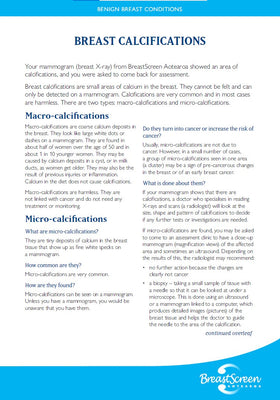Benign Breast Conditions: Breast Calcifications - HE1813

This fact sheet describes benign breast condition of calcifications or small areas of calcium in the breast. These are common and, in most cases, harmless. If calcifications are detected during a mammogram, the woman will be recalled for assessment. For BreastScreen Aotearoa professionals to use in the programme.
The full resource:
Your mammogram (breast X-ray) from BreastScreen Aotearoa showed an area of calcifications, and you were asked to come back for assessment.
Breast calcifications are small areas of calcium in the breast. They cannot be felt and can only be detected on a mammogram. Calcifications are very common and in most cases are harmless. There are two types: macro-calcifications and micro-calcifications.
Macro-calcifications
Macro-calcifications are coarse calcium deposits in the breast. They look like large white dots or dashes on a mammogram. They are found in about half of women over the age of 50, and in about 1 in 10 younger women. They may be caused by calcium deposits in a cyst, or in milk ducts, as women get older. They may also be the result of previous injuries or inflammation. Calcium in the diet does not cause calcifications.
Macro-calcifications are harmless. They are not linked with cancer and do not need any treatment or monitoring.
Micro-calcifications
What are micro-calcifications?
They are tiny deposits of calcium in the breast tissue that show up as fine white specks on a mammogram.
How common are they?
Micro-calcifications are very common.
How are they found?
Micro-calcifications can be seen on a mammogram. Unless you have a mammogram, you would be unaware that you have them.
Do they turn into cancer or increase the risk of cancer?
Usually, micro-calcifications are not due to cancer. However, in a small number of cases, a group of micro-calcifications seen in one area (a cluster) may be a sign of pre-cancerous changes in the breast or of an early breast cancer.
What is done about them?
If your mammogram shows that there are calcifications, a doctor who specialises in reading X-rays and scans (a radiologist) will look at the size, shape and pattern of calcifications to decide if any further tests or investigations are needed.
If micro-calcifications are found, you may be asked to come to an assessment clinic to have a close-up mammogram (magnification views) of the affected area and sometimes an ultrasound. Depending on the results of this, the radiologist may recommend:
- no further action because the changes are clearly not cancer
- a biopsy – taking a small sample of tissue with a needle so that it can be looked at under a microscope. This is done using an ultrasound or a mammogram linked to a computer, which produces detailed images (pictures) of the breast tissue and helps the doctor to guide the needle to the area of the calcification.
What the needle biopsy might show
1. Benign (non-cancerous) changes
There are many benign causes of micro-calcification. Some of the most common are:
- Fibrocystic change. The most common cause of breast lumps in women aged 30–50, fibrocystic changes occur because some of the breast tissue overreacts to normal monthly changes in hormonal levels. This can lead to scarring around the ducts, which can block the duct and cause micro (tiny) cysts to accumulate.
- Fibroadenoma. A fibroadenoma is a non-cancerous lump that grows in a young woman’s breast. With menopause and ageing, these can shrink and calcify.
- Fat necrosis. Previous injury, surgery or infection in the breast can cause scarring, which may calcify.
- Involution. Ageing of itself can cause calcifications.
None of these changes by themselves give you a significantly increased risk of breast cancer or turn into breast cancer.
The calcifications therefore do not need to be removed, nor do you need to be screened more often than other women your age.
You will be called back for your routine screening mammogram by BreastScreen Aotearoa in two years’ time.
2. ‘Indeterminate’ (uncertain) biopsy findings
Sometimes, if none of the calcifications are shown in the X-ray of the needle biopsy, or if there are uncertain changes when the pathologist looks at the tissue under the microscope, you will need to have another needle biopsy or have the area removed surgically. You will receive more information about the procedure if you are one of the few women who is advised to have this.
3. Cancer
When breast cancer cells are detected because of micro-calcification, they tend to be either ductal carcinoma in situ (DCIS) – pre-invasive cancerous changes in the milk ducts of the breast – or small early breast cancers that have not spread.
The small number of women this affects will be referred for treatment.
What happens if you have benign changes only?
BreastScreen Aotearoa will invite you for your next mammogram when it is due, if you are still eligible.
Your calcifications do not increase your risk of developing a cancer compared with other women your age. You should continue to have mammograms at the normal two-yearly intervals.
If you notice a new lump or anything else unusual in either breast, see a doctor without delay.
For more information
If you have questions not answered by this sheet, ask the breastcare nurse you saw at BreastScreen Aotearoa.